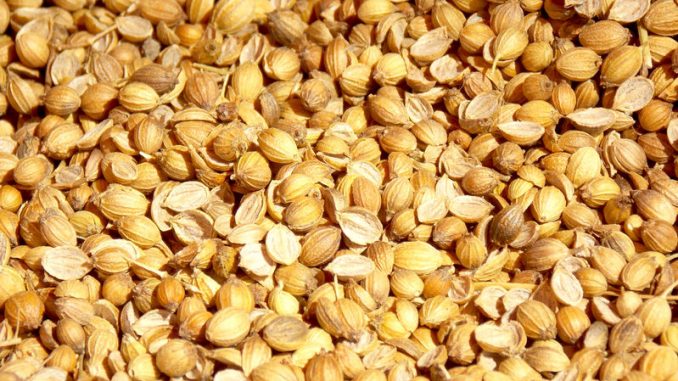
Parsley (Petroselinum sativum Hoffm.) is a hardy biennial in the Apiaceae family (formerly called the Umberlliferae) which is widely grown as a herb for garnishes and seasoning.
The parsley seed contains an essential oil which mainly contains the compounds, myristicin, apiole, and 2,3,4,5-tetramethoxyallylbenzene (Guenther, 1950; Bauer et al., 1997). The compounds apha-pinene and beta-pinene, beta-phellandrene, limonene, dillapiole, and elemicin have also been identified. These compounds are mainly responsible for its flavour. The oil itself ranges in colour from clear to a pale yellow. It is herbaceous with a slight characteristic spicy note.
The seed oil also contains up to 75% by weight of petroselenic acid (6-octadecenoic acid) and rivals coriander seed oil (Coriandrum sativum) in terms of this content (Privett et al., 1963).
The oil is commercially extracted using steam distillation or supercritical carbon dioxide.
Possible Health Benefits
A number of traditional claims are made for the product. Very few have been substantiated but they include:-
- Stimulation of the appetite
- Improving the rate of digestion
- Relief of arthritis and rheumatism
- Diuretic
- Urinary tract infections
- Reducing sepsis although this remains to be substantiated to a great degree
- Acts as an astringent
- Relieves flatulence
- Improves digestion
- Serves as an emmenagogue
- Fever reduction
- Reduces hypertension
It would appear there are many more benefits but the clinical evidence is few and far between. It is however well noted for helping to reduce the aroma of food on the breath especially garlic.
One study from the University of California assessed the antioxidant behaviour of a number of essential seed oils (Wei and Shibamoto, 2007). They looked at the protection afforded to the UV light damage of a skin compound called squalene. The essential oils examined were thyme, clove leaf with cinnamon leaf, rose and parsley seed. A number were tested in combinations too. Whilst thyme and clove leaf oils proved highly effective at inhibiting the formation of malonaldehyde which is a measure of fat breakdown, parsley seed oil also proved highly effective.
Parsley seed oil also has antibacterial properties which may in part explain why it is used for reducing levels of sepsis. A 2016 study found the oil inhibited the growth of various bacterial species including Staphylococcus aureus, Listeria monocytogenes, and Salmonella enterica. These are all well known food borne bacteria. Unfortunately a much later study showed inconclusive results against similar food-borne microorganisms (Semeniuc et al., 2017).
There are a number of issues associated with it as it is believed to widely interact with drugs.
Products
Parsley seed oil is often added to garlic supplements as a way to reduce the aroma of garlic on the breath. There is a certain degree of success with this approach and it has been a successful ingredient in traditional cuisine.
Please not this article contains links to our affiliate marketing partner. Please read our affiliate disclaimer.
References
Bauer, K., Garbe, D., Surburg, H. (1997) Common Fragrance and Flavor Materials: Preparation, Properties and Uses, third ed., Wiley, Germany, p. 204.
Guenther, E. (1950) The Essential Oils, vol. IV, Van Nostrand, USA, p. 659
Linde, G. A., Z. C. Gazim, B. K. Cardoso, L. F. Jorge, V. Tešević, J. Glamoćlija, M. Soković, and N. B. Colauto. “Antifungal and antibacterial activities of Petroselinum crispum essential oil.” Genet Mol Res 15, no. 3 (2016): 15038538. https://www.ncbi.nlm.nih.gov/pubmed/27525894
Privett, O.S., Nadenicek, J.D., Weber, R.P., Pusch, F.J. (1963) Petroselenic acid and nonsaponifiable constituents of parsley seed oil. J. Amer. Oil Chem. Soc. 40 (1) pp. 28-30
Semeniuc, C. A., Pop, C. R., & Rotar, A. M. (2017). Antibacterial activity and interactions of plant essential oil combinations against Gram-positive and Gram-negative bacteria. Journal of food and drug analysis, 25(2), pp. 403-408. https://www.sciencedirect.com/science/article/pii/S1021949816300801
Wei, A & Shibamoto, T. (2007) Antioxidant Activities of Essential Oil Mixtures toward Skin Lipid Squalene Oxidized by UV Irradiation, Cutaneous and Ocular Toxicology, 26(3), pp. 227-233, DOI: 10.1080/15569520701224501
Leave a Reply